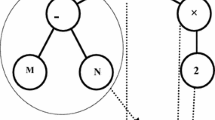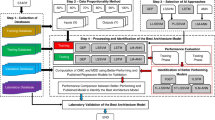Abstract
Heterogeneous nature of soil consists of various chemical and physical attributes that make the prediction of soil parameters very tedious and challenging. Moreover, it becomes more difficult when we have more number of variables. This study investigates the feasibility of principal component analysis as dimensionality reduction technique to select the input variables in terms of principal components (PCs), which helps in reducing the complexity and multicollinearity problem. The soil attributes, namely depth of the sample, sand percentage, silt percentage, clay percentage, moisture content, dry density, wet density, void ratio, liquid limit, plastic limit, liquid index, and plastic index, have been employed as influencing factors to estimate the coefficient of compression of soil. Furthermore, the extracted variance-based PCs were used as predictor to build the minimax probability machine regression (MPMR), multivariate adaptive regression splines (MARS), and genetic programming regression (GPR). The predictive accuracy of the models has been assessed via five statistical fitness parameters. In the training phase, the PCA-MARS model has shown good outcomes in terms of fitness measurement parameters (RMSE= 0.004, r = 0.981 and NSE = 0.963). During testing phase, PCA-MARS has outperformed (RMSE= 0.006, r = 0.963 and NSE = 0.912) followed by PCA-GPR and PCA-MPMR. The finding of this research concludes that PCA-based MARS model can be used as new and reliable data-driven approach for estimation of soil parameters. Furthermore, this new tool can help to save the time and capital spent on estimation of different parameter of soil.







Similar content being viewed by others
References
Bayat H, Ebrahimi E, Fallah M (2018) Estimation of soil moisture using confined compression curve parameters. Geoderma 318:64–77. https://doi.org/10.1016/j.geoderma.2017.12.034
Bertsimas D, Popescu I (2005) Optimal inequalities in probability theory: a convex optimization approach. SIAM J Optim 15:780–804
Burland JB (1990) On the compressibility and shear strength of natural clays. Géotechnique 40:329–378. https://doi.org/10.1680/geot.1990.40.3.329
Cevik A (2007) A new formulation for longitudinally stiffened webs subjected to patch loading. J Constr Steel Res 63:1328–1340
Cheng M-Y, Hoang N-D (2015) Typhoon-induced slope collapse assessment using a novel bee colony optimized support vector classifier. Nat Hazards 78:1961–1978. https://doi.org/10.1007/s11069-015-1813-8
Chu C, Wu Z, Deng Y, Chen Y, Wang Q (2017) Intrinsic compression behavior of remolded sand–clay mixture. Can Geotech J 54:926–932. https://doi.org/10.1139/cgj-2016-0453
Ferreira C (2001) Algorithm for solving gene expression programming: a new adaptive problems. Complex Syst 13:87–129
Friedman JH (1991) Multivariate adaptive regression splines. Ann Stat 19:1–67
Gulhati SK, Datta M (2005) Geotechnical engineering. Tata Mc Graw Hill Publishing Company Limited, New Delhi. ISBN 0-07-058829-5
Hoang N-D, Chen C-T, Liao K-W (2017) Prediction of chloride diffusion in cement mortar using multi-gene genetic programming and multivariate adaptive regression splines. Measurement 112:141–149. https://doi.org/10.1016/j.measurement.2017.08.031
Hoang N-D, Tien Bui D (2018) Spatial prediction of rainfall-induced shallow landslides using gene expression programming integrated with GIS: a case study in Vietnam. Nat Hazards. https://doi.org/10.1007/s11069-018-3286-z
Junhui L, Chao W, Xianlin L, Decai M, Fuquan Z, Yongjun Z (2018) Prediction of soft soil foundation settlement in Guangxi granite area based on fuzzy neural network model. IOP Conf Ser Earth Environ Sci 108:032034
Khosravi K, Nohani E, Maroufinia E, Pourghasemi HR (2016) A GIS-based flood susceptibility assessment and its mapping in Iran: a comparison between frequency ratio and weights-of-evidence bivariate statistical models with multi-criteria decision-making technique. Nat Hazards 83:947–987. https://doi.org/10.1007/s11069-016-2357-2
Koppula S (1981) Statistical estimation of compression index. Geotech Test J 4:68–73
Koza J (1992) Genetic programming on the programming of computers by means of natural selection. The MIT Press, Cambridge
Kurnaz TF, Dagdeviren U, Yildiz M, Ozkan O (2016) Prediction of compressibility parameters of the soils using artificial neural network. SpringerPlus 5:1801. https://doi.org/10.1186/s40064-016-3494-5
Lanckriet G, Ghaoui LE, Bhattacharyya C, Jordan MI (2002) Minimax probability machine. In: Advances in neural information processing systems, pp 801–807
Lemon J et al (2009) Plotrix: Various plotting functions. R package version 2.7-2. R Project for Statistical Computing, Vienna
Lewis PA, Stevens JG (1991) Nonlinear modeling of time series using multivariate adaptive regression splines (MARS). J Am Stat Assoc 86:864–877
Li C (2014) A simplified method for prediction of embankment settlement in clays. J Rock Mech Geotech Eng 6:61–66. https://doi.org/10.1016/j.jrmge.2013.12.002
Marshall AW, Olkin I (1960) Multivariate Chebyshev inequalities. Ann Math Stat 1:1001–1014
Mayne PW (1980) Cam-clay predictions of undrained strength. J Geotech Eng Div ASCE 106:1219–1242
Mehr AD, Kahya E, Olyaie E (2013) Streamflow prediction using linear genetic programming in comparison with a neuro-wavelet technique. J Hydrol 505:240–249
Moayed RZ, Kordnaeij A, Mola-Abasi H (2017) Compressibility indices of saturated clays by group method of data handling and genetic algorithms. Neural Comput Appl 28:551–564. https://doi.org/10.1007/s00521-016-2390-9
Moayedi H, Armaghani DJ (2018) Optimizing an ANN model with ICA for estimating bearing capacity of driven pile in cohesionless soil. Eng Comput 34:347–356
Moayedi H, Hayati S (2018) Modelling and optimization of ultimate bearing capacity of strip footing near a slope by soft computing methods. Appl Soft Comput 66:208–219
Moayedi H, Mehrabi M, Mosallanezhad M, Rashid ASA, Pradhan B (2018) Modification of landslide susceptibility mapping using optimized PSO-ANN technique. Eng Comput 1:1–18
Moayedi H, Rezaei A (2019) An artificial neural network approach for under-reamed piles subjected to uplift forces in dry sand. Neural Comput Appl 31:327–336
Moghaddas Tafreshi SN, Shaghaghi T, Tavakoli Mehrjardi G, Dawson AR, Ghadrdan M (2015) A simplified method for predicting the settlement of circular footings on multi-layered geocell-reinforced non-cohesive soils. Geotext Geomembr 43:332–344. https://doi.org/10.1016/j.geotexmem.2015.04.006
Mohammadzadeh D, Bolouri BJ, Alavi AH (2014) An evolutionary computational approach for formulation of compression index of fine-grained soils. Eng Appl Artif Intell 33:58–68. https://doi.org/10.1016/j.engappai.2014.03.012
Mohammadzadeh SD, Bolouri BJ, Vafaee JYSH, Alavi AH (2016) Deriving an intelligent model for soil compression index utilizing multi-gene genetic programming. Environ Earth Sci 75:262. https://doi.org/10.1007/s12665-015-4889-2
Mosallanezhad M, Moayedi H (2017) Developing hybrid artificial neural network model for predicting uplift resistance of screw piles. Arab J Geosci 10:479
Muñoz DG (2005) Discovering unknown equations that describe large data sets using genetic programming techniques. Master’s Thesis, Linköping Institute of Technology
Nagaraj T, Srinivasa Murthy B (1985) Prediction of the preconsolidation pressure and recompression index of soils. Geotech Test J 8:199–202
Park HI, Lee SR (2011) Evaluation of the compression index of soils using an artificial neural network. Comput Geotech 38:472–481
Pearson K (1901) LIII. On lines and planes of closest fit to systems of points in space. Lond Edinburgh Dublin Philos Mag J Sci 2:559–572
Pham BT, Son LH, Hoang T-A, Nguyen D-M, Tien Bui D (2018) Prediction of shear strength of soft soil using machine learning methods. CATENA 166:181–191. https://doi.org/10.1016/j.catena.2018.04.004
Polidori E (2015) On the intrinsic compressibility of common clayey soils. Eur J Environ Civ Eng 19:27–47. https://doi.org/10.1080/19648189.2014.926295
Puri N, Prasad HD, Jain A (2018) Prediction of geotechnical parameters using machine learning techniques. Proced Comput Sci 125:509–517. https://doi.org/10.1016/j.procs.2017.12.066
Rendon-Herrero O (1983) Universal compression index equation. J Geotech Eng Div ASCE 109:1179–1200
Sreekanth J, Datta B (2011) Coupled simulation-optimization model for coastal aquifer management using genetic programming-based ensemble surrogate models and multiple-realization optimization. Water Resour Res 47:4
Sridharan A, Nagaraj HB (2000) Compressibility behaviour of remoulded, fine-grained soils and correlation with index properties. Can Geotech J 37:712–722. https://doi.org/10.1139/t99-128
Strohmann T, Grudic GZ (2003) A formulation for minimax probability machine regression. In: Advances in neural information processing systems, pp 785–792
Taylor KE (2001) Summarizing multiple aspects of model performance in a single diagram. J Geophys Res Atmos 106:7183–7192
Teodorescu L, Sherwood D (2008) High energy physics event selection with gene expression programming. Comput Phys Commun 178:409–419
Terzaghi K, Peck RB, Mesri G (1996) Soil mechanics in engineering practice. Wiley, Oxford
Tinoco J, Correia AG, Cortez P, Toll DG (2018) Stability condition identification of rock and soil cutting slopes based on soft computing. J Comput Civ Eng 32:04017088. https://doi.org/10.1061/(ASCE)CP.1943-5487.0000739
Tiwari B, Ajmera B (2012) New correlation equations for compression index of remolded clays. J Geotech Geoenviron Eng 138:757–762. https://doi.org/10.1061/(ASCE)GT.1943-5606.0000639
Wang J-J, Qiu Z-F, Hao J-Y, Zhang J-T (2016) Compression characteristics of an artificially mixed soil from confined uniaxial compression tests. Environ Earth Sci 75:152. https://doi.org/10.1007/s12665-015-5042-y
Wang J, Zhong D, Wu B, Shi M (2018) Evaluation of compaction quality based on SVR with CFA: case study on compaction quality of earth-rock dam. J Comput Civ Eng 32:05018001. https://doi.org/10.1061/(ASCE)CP.1943-5487.0000742
Acknowledgements
This research was supported by the Geographic Information Science Research group, Ton Duc Thang University, Ho Chi Minh city, Vietnam. We would like to thank the Nam Cuong Ha Noi Corporation Joint Stock Company and TOMAS JSC for providing the data for this research.
Author information
Authors and Affiliations
Corresponding author
Ethics declarations
Conflict of interest
We declare that we do not have any commercial or associative interest that represents a conflict of interest in connection with the work submitted.
Additional information
Publisher’s Note
Springer Nature remains neutral with regard to jurisdictional claims in published maps and institutional affiliations.
Rights and permissions
About this article
Cite this article
Nhu, VH., Samui, P., Kumar, D. et al. Advanced soft computing techniques for predicting soil compression coefficient in engineering project: a comparative study. Engineering with Computers 36, 1405–1416 (2020). https://doi.org/10.1007/s00366-019-00772-7
Received:
Accepted:
Published:
Issue Date:
DOI: https://doi.org/10.1007/s00366-019-00772-7




